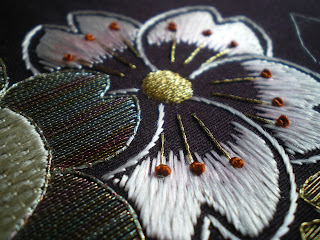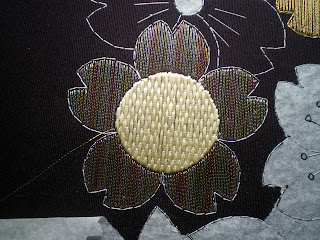For the third of the large centred flowers I had a slightly different plan. It was a combination of something I had seen in the
Kurenia-kia exhibition and a homage to one of my favourite Kusano-san designs. I have already referenced
Hana utsuroi (Transient Flowers) in my
Shibori Samuri. In her piece Kusano-san fills some of the butterfly wings with flowers. In my
Flower Circle I filled one of my flowers with butterflies!
I traced the outline of the remaining flower and played around drawing butterflies into the space. When I was happy with the design I retraced it onto tissue paper. I thought that the butterflies were a bit small to stitch transfer so decided to transfer them with shell powder. I have not had much success with this method in the past but while in Atlanta I was able to observe how Uematsu-san did it. The shell powder is mixed with a little water. I observed that Uematsu-san used less water that I do making a slightly thicker solution. I also observed that Uematsu-san painted more of the solution onto the reverse of the tracing than I did. When the paper was completely dry this left a heavier deposit of shell powder. I carefully placed the tracing onto my fabric – I had traced the outline of the flower so that I could position the tracing accurately. Then with a book pressed to the underside of my fabric I firmly rubbed over the tracing paper with the back of my thumb nail.

© Shizuka Kusano/Carol-Anne Conway
This certainly transferred a goodly amount of shell power that showed clearly on my fabric but, oh my, the outlines were very thick on those tiny butterflies. I could just make out enough of the shape to give me an impression of each butterfly and as they are so small I decided to stitch them freehand using the 'lines' to guide me.
© Shizuka Kusano/Carol-Anne Conway
© Shizuka Kusano/Carol-Anne Conway
They are a bit asymmetrical but I figured that they looked like they were flitting around. I was slightly concerned about the residue of shell powder but a good beating with my velvet cushion removed all trace of the powder and I was ready for the next step.
© Shizuka Kusano/Carol-Anne Conway
At the Osaka exhibition I had seen some motifs that had another motif stitched inside them with
sugabiki (fuzzy effect) over the top. I thought the effect was very lacy and delicate. As with the other large centred flowers I filled the petals with
sugabiki but this time I only stitching in every other weft valley so that the butterflies would still be visible under the #1 gold thread.
© Shizuka Kusano/Carol-Anne Conway
I then filled the flower centre in the same way but stitching into the valleys that had been left unstitched on the petals to give a staggered effect. I hoped that this would differentiate the centre from the petals but the effect was too subtle so I went back and stitched into the remaining valleys with the shell gold thread.
© Shizuka Kusano/Carol-Anne Conway
© Shizuka Kusano/Carol-Anne Conway
Finally I outlined the petals and the centre of the flower with couched twisted gold.
© Shizuka Kusano/Carol-Anne Conway
Happy Stitching




















































